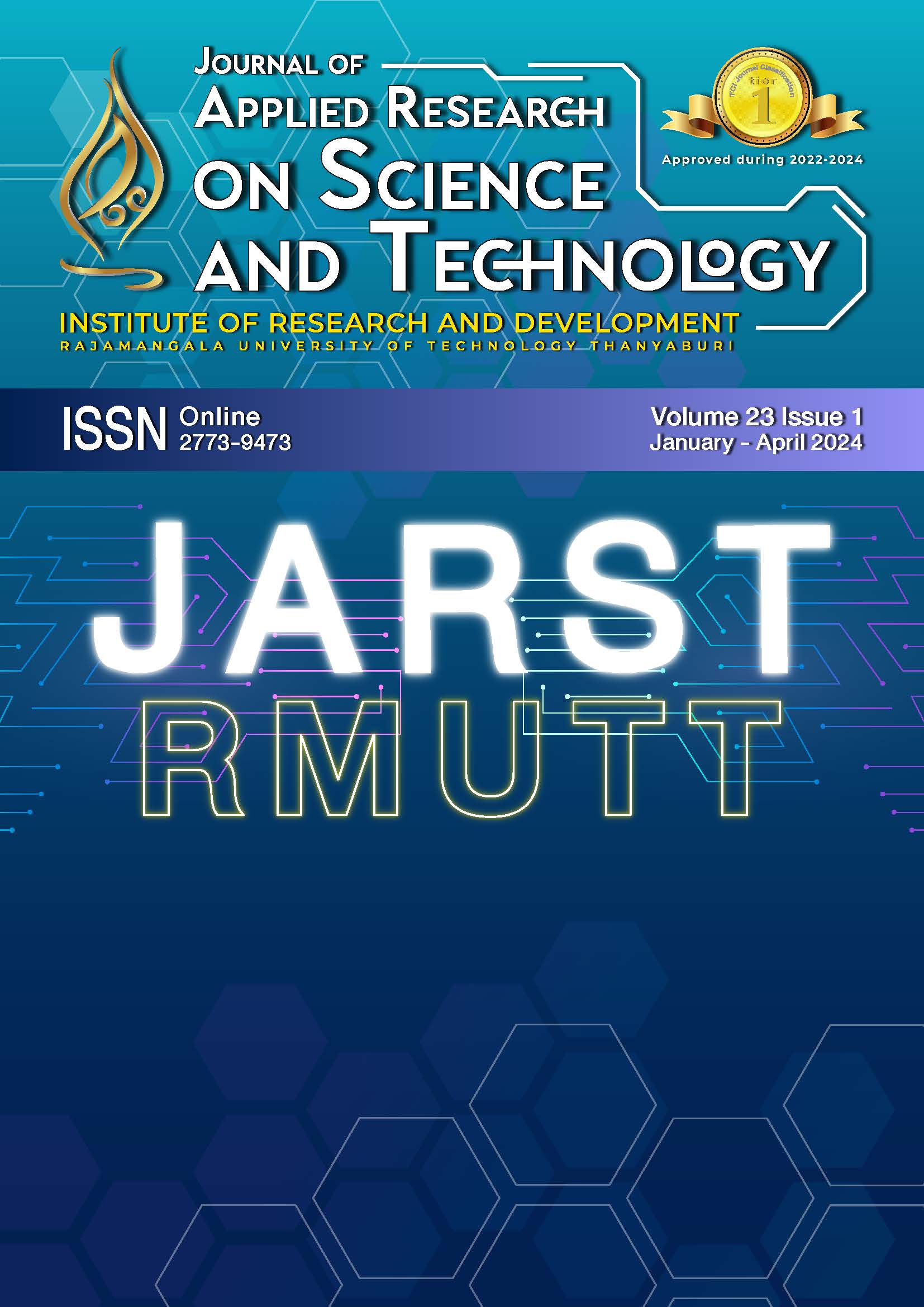Improvement of heat-sealing strength of chitosan-based composite films and product costs analysis in the production process
Main Article Content
Abstract
The primary objective of this study was to enhance the heat-sealing strength of composite films made from chitosan and analyze the associated product costs. The approach adopted involved formulating chitosan-based composite films by incorporating gelatin and green seaweed extract. This strategic combination resulted in a notable improvement in heat-sealing strength. The ensuing attributes underwent meticulous examination, encompassing seal strength, FTIR spectroscopy, FE-SEM surface morphology analysis, and DSC thermal properties determination. Data analysis was rigorously conducted using the SPSS program, with outcomes presented as mean values accompanied by standard deviations. Disparities were discerned at a 95% confidence level, ensuring statistical robustness. The findings unveiled that the incorporation of 10% gelatin and 1% green seaweed extract substantially enhanced the seal strength of the chitosan-based composite films. Notably, the introduction of green seaweed extracts disrupted interactions between chitosan's structure and various molecular vibrations. This disruption, coupled with increased ionic interactions and hydrogen bonding, led to improved molecular interdiffusion, ultimately resulting in modified heat sealability. The study identified the optimized conditions as 10% gelatin and 1% green seaweed extract concentrations, which produced the highest seal strength at 19.4 N/m. Further evidence from scanning electron microscopy demonstrated improved interfacial adhesion, attributed to the adjusted surface morphology. The film surface did not contain small scattered particles and presented a smooth phase. This suggests that the chitosan-based composite achieved good interfacial adhesion between the two components in these films. As an essential aspect for practical application, the total production cost of the films was determined to be 606.84 baht. This information renders the data collection from the study valuable for companies seeking to enhance production efficiency and overall profitability.
Article Details

This work is licensed under a Creative Commons Attribution-NonCommercial-NoDerivatives 4.0 International License.
References
Agarwal C, Koczan Z, Borcsok Z, Halasz K, Pasztory Z. Valorization of Larix decidua Mill bark by functionalizing bioextract onto chitosan films for sustainable active food packaging. Carbohyd Polym. 2021;271:1-11.
Haghighi H, Licciardello F, Fava P, Siesler HW, Pulvirenti A. Recent advances on chitosan-based films for sustainable food packaging applications. Food Packaging and Shelf Life. 2020;6:1-16.
Wang W, Xue C, Mao X. Chitosan: Structural modification, biological activity and application. Int J Biol Macromol. 2020;164:4532-46.
Ren L, Yan X, Zhou J, Tong J, Su X. Influence of chitosan concentration on mechanical and barrier properties of corn starch/chitosan films. Int J Biol Macromol. 2017;105:1636-43.
Zheng K, Xiao S, Li W, Wang W, Chen H, Yang F, et al. Chitosan acorn starch-eugenol edible film: Physico-chemical, barrier, antimicrobial, antioxidant and structural properties. Int J Biol Macromol. 2019;135:344-52.
Alves Z, Ferreira NM, Ferreira P, Nunes C. Design of heat sealable starch-chitosan bioplastics reinforced with reduced graphene oxide for active food packaging. Carbohyd Polym. 2022;291:1-11.
Prateepchanachai S, Thakhiew W, Devahastin S, Soponronnarit S. Improvement of mechanical and heat-sealing properties of edible chitosan films via addition of gelatin and CO2 treatment of film- forming solutions. Int J Biol Macromol. 2019;131:589-600.
Prateepchanachai S. Improvement of heat-sealing properties of composite chitosan films via the use of gelatin and green seaweed blends in film-forming solutions. UBU Engineering Journal. 2021;14(4):150-60.
American society for testing and materials (ASTM). Standard test method for seal strength of flexible barrier materials (F88). Annual Book of ASTM Standards. Philadelphia PA; 2005.
Souza BWS, Cerqueira MA, Martins JT, Casariego A, Teixeira JA, Vicente AA. Influence of electric fields on the structure of chitosan edible coatings. Food Hydrocolloids. 2010;24:330-35.
Castello ME, Anbinder PS, Amalvy JI, Peruzzo PJ. Production and characterization of chitosan and glycerol-chitosan films. Materials Research Society. 2018;3:3601-10.
Tripathi S, Mehrotra GK, Dutta PK. Physicochemical and bioactivity of cross-linked chitosan-PVA film for food packaging applications. Int J Biol Macromol. 2009;45:372-76.
Putri RL. Analysis of production of calculations using process costing method in SULI TAFU factory. Jurnal Online Universitas 45 Surabaya [Internet]. 2017 [cited 2022 Dec 31]; 6-13. Available From: https://core.ac.uk/download/pdf/235584423.pdf.


